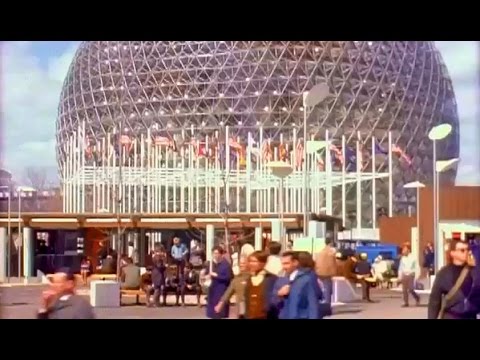more at
High quality color footage of Expo 67, Montreal. Silent.
Public domain film from the Prelinger Archives, slightly cropped to remove uneven edges, with the aspect ratio corrected, and mild video noise reduction applied.
The soundtrack was also processed with volume normalization, noise reduction, clipping reduction, and/or equalization (the resulting sound, though not perfect, is far less noisy than the original).
The 1967 International and Universal Exposition or Expo 67, as it was commonly known, was the general exhibition, Category One World’s Fair held in Montreal, Quebec, Canada, from April 27 to October 29, 1967. It is considered to be the most successful World’s Fair of the 20th century, with the most attendees to that date and 62 nations participating. It also set the single-day attendance record for a world’s fair, with 569,500 visitors on its third day.
Expo 67 was Canada’s main celebration during its centennial year. The fair was originally intended to be held in Moscow, to help the Soviet Union celebrate the Russian Revolution’s 50th anniversary; however, for various reasons, the Soviets decided to cancel, and Canada was awarded it in late 1962.
The project was not originally overwhelmingly supported in Canada. It took the determination of Montreal’s mayor, Jean Drapeau, and a new team of managers to guide it past political, physical and temporal hurdles. Defying a computer analysis that said it could not be done, the fair opened on time.
After Expo 67 ended in October 1967, the site and most of the pavilions continued on as an exhibition called Man and His World, open during the summer months from 1968 until 1984. By that time, most of the buildings — which had not been designed to last beyond the original exhibition — had deteriorated and were dismantled. Today, the islands that hosted the world exhibition are mainly used as parkland and for recreational use, with only a few remaining structures from Expo 67 to show that the event was held there…
Construction started on August 13, 1963… The 25 million tons of fill needed to construct the islands was coming from the Montreal metro’s excavations, a public works project that was already under construction before Expo was awarded to Montreal. Expo’s initial construction period mainly centred on enlarging Saint Helen’s Island, creating the artificial island of Notre Dame Island and lengthening and enlarging the Mackay Pier which became the Cité du Havre… the grounds that would hold the fair were officially transferred from the City of Montreal to the corporation on June 20, 1964. This gave Colonel Churchill only 1042 days to have everything built and functioning for opening day. To get Expo built in time, Churchill used the then new project management tool known as the critical path method (CPM). On April 28, 1967, opening day, everything was ready, with one exception: Habitat 67, which was then displayed as a work in progress.
Building and enlarging the islands, along with the new Concorde Bridge built to connect them with the site-specific mass transit system known as the Montreal Expo Express, plus a boat pier, cost more than the Saint Lawrence Seaway project did only five years earlier: this was even before any buildings or infrastructure were constructed… In the fall of 1963, Expo’s general manager, Andrew Kniewasser, presented the master plan and the preliminary budget of $167 million for construction: it would balloon to over $439 million by 1967…
Official opening ceremonies were held on Thursday afternoon, April 27, 1967…
…The Ed Sullivan Show was broadcast live on May 7 and May 21 from Expo 67. Stars on the shows included America’s The Supremes, Britain’s Petula Clark and Australia’s The Seekers…
Expo 67 closed on Sunday afternoon, October 29, 1967. On the final day 221,554 visitors added to the more than 50 million (50,306,648) that attended Expo 67 at a time when Canada’s population was only 20 million, setting a per-capita record for World Exhibition attendance that still stands… All rides and the minirail were shut down by 3:50 p.m., and the Expo grounds closed at 4:00 p.m., with the last Expo Express train leaving for Place d’Accueil at that time. A fireworks display, that went on for an hour, was Expo’s concluding event.
…Expo was intended to have a deficit, shared between the federal, provincial and municipal levels of government. Significantly better-than-expected attendance revenue reduced the debt to well below the original estimates. The final financial statistics, in 1967 Canadian dollars, were: revenues of $221,239,872, costs of $431,904,683, and a deficit of $210,664,811…

